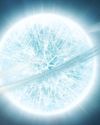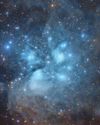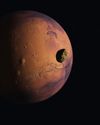MYSTERIES OF THE UNIVERSE - WHERE DID EARTH GET ITS WATER FROM?
All About Space UK
|Issue 144
Two new scientific studies have sailed researchers ever closer to discovering the source of Earth's water

Water covers 71 per cent of the surface of Earth, and most of it – some 96.5 per cent – is contained within our planet’s oceans. The remaining 3.5 per cent is freshwater and therefore drinkable, but most of that – 68 per cent – is sealed within glaciers and ice. Such statistics are well known and equally well trodden, but they’re intriguing nonetheless. After all, Earth is something of an anomaly, given that it’s the only world in our Solar System with extensive, consistent and stable regions of liquid water at the surface – and no one knows exactly how this came to be.
To understand the mystery of Earth’s water, you need to take into account the Solar System’s snow line – the distance from the Sun beyond which water is present as ice. When the Solar System was formed, this line was between the orbits of Mars and Jupiter. Planets that formed within the line would see water turn to vapour; those beyond could accrete water ice. “It is surprising that Earth has so much water because it formed in the inner Solar System, likely within the snow line,” explains Megan Newcombe, assistant professor of geology at the University of Maryland. “The Earth accreted in a region of the solar nebula that was quite near the Sun, and therefore was likely warm and relatively dry. Water ice accretion to the early Earth was probably limited.”
Yet if the newborn Earth’s proximity to the Sun was likely to have left it dry, how and when did the planet produce its water supply? For many years, scientists have proposed that it came in massive quantities from elsewhere in the Solar System, but proof of the exact source has eluded them.
This story is from the Issue 144 edition of All About Space UK.
Subscribe to Magzter GOLD to access thousands of curated premium stories, and 10,000+ magazines and newspapers.
Already a subscriber? Sign In
MORE STORIES FROM All About Space UK

All About Space UK
MYSTERIES OF THE UNI WHERE ARE ALL THE SPIRAL GALAXIES?
There are far fewer spiral galaxies than elliptical ones in the Supergalactic Plane, and scientists are keen to discover why
7 mins
Issue 161

All About Space UK
ZOMBIE STARS
+10 OTHER TERRIFYING SPACE OBJECTS
8 mins
Issue 161

All About Space UK
HOW TO BEAT LIGHT POLLUTION
Thought it was impossible to observe the wonders of the night sky from towns and cities? Think again. Follow our tips and tricks on successfully observing through sky glow
2 mins
Issue 161

All About Space UK
15 STUNNING STAR CLUSTERS
These beautiful stellar groupings are spattered across the cosmos
8 mins
Issue 161

All About Space UK
Eileen Collins "It was a difficult mission...we were the first to see Mir"
Having served as both the first female pilot and first female commander of NASA's Space Shuttle, Collins boosted the involvement of women in space exploration to a whole new level
9 mins
Issue 161

All About Space UK
MARS LEAKS FASTER WHEN IT'S CLOSER TO THE SUN
The Red Planet has lost enough water to space to form a global ocean hundreds of kilometres deep
2 mins
Issue 161

All About Space UK
FUTURE TECH KANKOH-MARU
This ambitious reusable spacecraft will be capable of taking 50 people to and from orbit
2 mins
Issue 161

All About Space UK
THE FINAL FRONTIER
Beyond the reach of the Sun is a fascinating region of the cosmos that were only just beginning to explore
8 mins
Issue 161

All About Space UK
A long-lost moon could explain Mars' weird shape and extreme terrain
A long-lost moon could explain why Mars is so different from the other rocky planets in the Solar System. Today Mars has two tiny moons.
2 mins
Issue 161

All About Space UK
A sprinkling of cosmic dust may have helped kick-start life on Earth
Cosmic dust may have helped kick-start life on Earth. New findings challenge a widely held assumption that this wasn't a plausible explanation.
3 mins
Issue 161
Translate
Change font size

